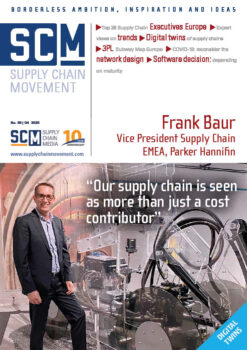How digital twins support autonomous supply chains

Companies are accelerating their supply chain optimization efforts and are using new technologies to integrally plan and manage their end-to-end supply chains. Both SKF and Medtronic have set up a digital twin of their supply chain for this purpose. This is time-consuming and cost-intensive, but the results are worth it.
By Marcel te Lindert
Not so long ago, SKF’s supply chain regularly struggled with bullwhip effects. If the planner at one of the company’s local warehouses around the world saw a rise in demand for a certain type of ball bearing, he adjusted the forecast and increased the safety stock. Those adjustments triggered his colleagues upstream in the chain to do the same. The result: unnecessarily high stocks throughout the supply chain. “Or imagine a local warehouse that suddenly has excess stock because of a drop in demand from a particular customer. The normal response would be to release that stock back into the chain and make it available to other customers, but that regularly sparked discussions within SKF; nobody wanted that stock, because everyone was already at their maximum inventory levels,” says Jörg Schlager, Business Transformation Manager at SKF Group.
These problems were caused by the fragmented supply chain. “SKF has a large number of factories and warehouses around the world, and each had their own planners. All those planners had their own processes, systems, responsibilities and KPIs. That led to sub-optimization,” explains Schlager.
The turning point began when the new CEO, Alrik Danielson, arrived in 2015. He was quick to point out the danger of disruption and forced the company to reinvent itself. Schlager: “He asked about our supply chain strategy. We have to admit that back then it lacked a guiding principle. In reality, it didn’t go much further than platitudes such as better performance and lower stocks. It lacked a clear vision. And we weren’t even improving our scores for the goals that we did have anymore. We’d reached the limits of what was possible with our supply chain set-up at that time.”
SQL database
Since 2016, SKF has continuously been working on a new approach based on a digital twin of the supply chain which combines data from various IT systems. “Within our team, we often joke that a digital twin is just a big SQL database,” says Schlager with a smile. “Alternatively, we could have waited until we’d implemented a global ERP system with harmonized processes, but that would have taken us an extra five, ten or perhaps even 15 years. We couldn’t afford to wait that long.”
The digital twin forms the basis for a new, globally integrated planning approach. At its heart is Tools Group’s SO99+ planning system, which is fed with data from the digital twin. The system generates a statistical forecast which human planners then enrich with insights from the continuous sales & operations planning (S&OP) process, among other things. SO99+ then calculates the optimal service levels and safety stocks, taking account of orders, delivery times, lead times and much more. This results in replenishment orders for the stocks in all warehouses. “The planning is largely automated. As long as service levels and stock levels remain within the predefined parameters, there is no need for manual intervention. But if we see a deviation, for example because the stock in a warehouse is going to exceed the minimum or maximum level, the planner who is responsible receives an alert. Then we need his brainpower to fix it – and if possible prevent it from occurring again,” explains Schlager. … … …
 Want to read more?
Want to read more?
Subscribe to the digital subscription to read the full version >>
or
This article was first published in Supply Chain Movement 39 | Q4 – 2020










